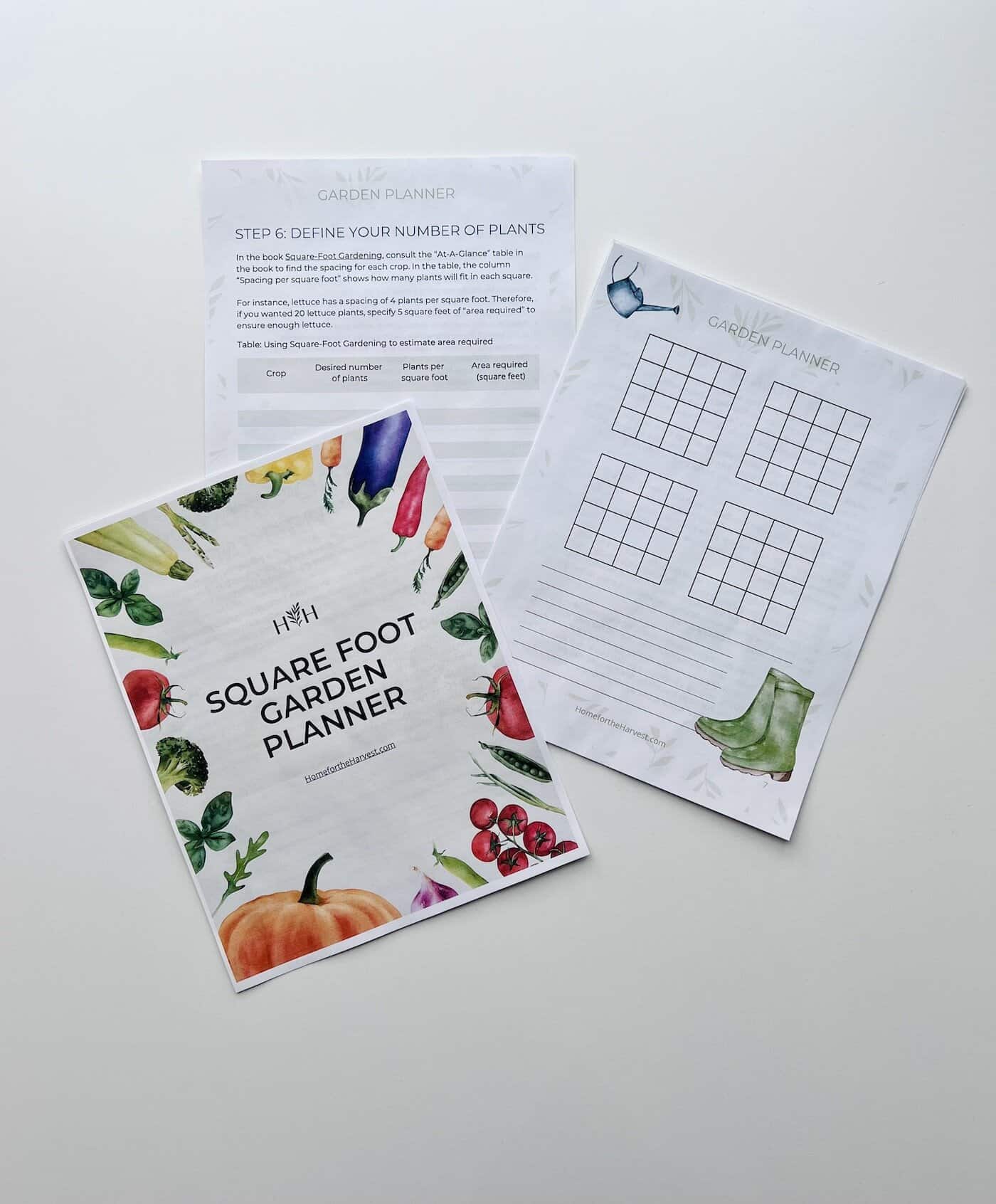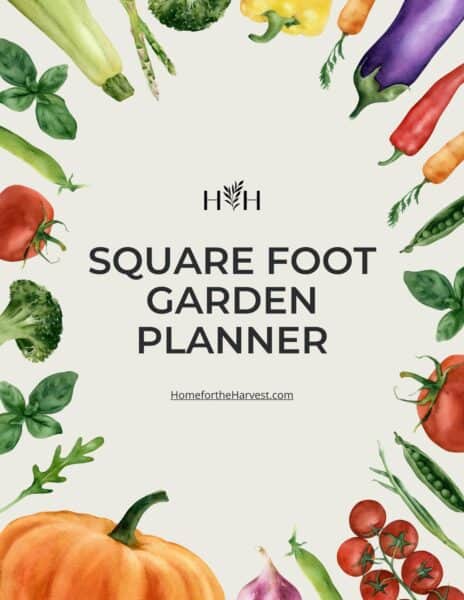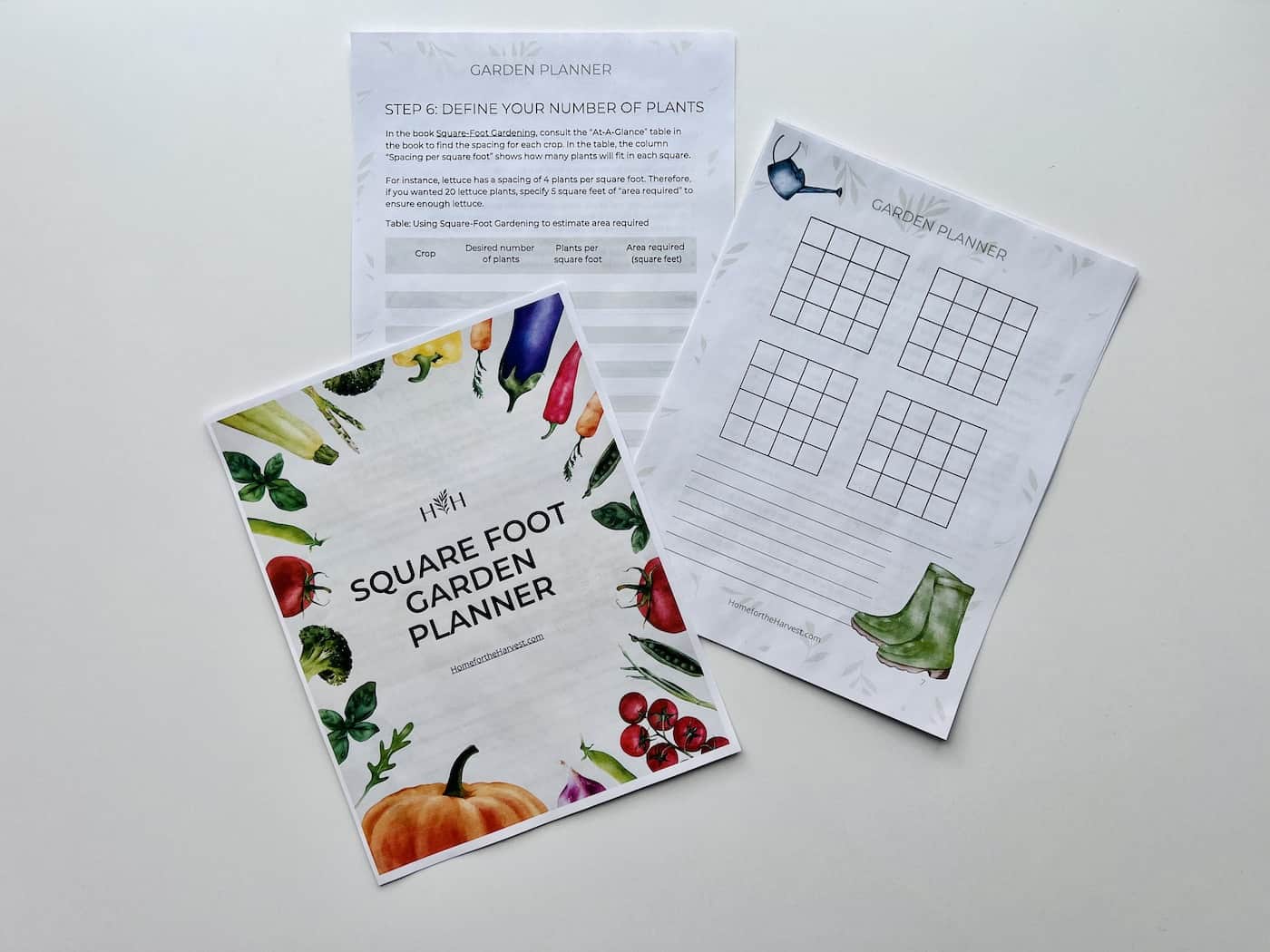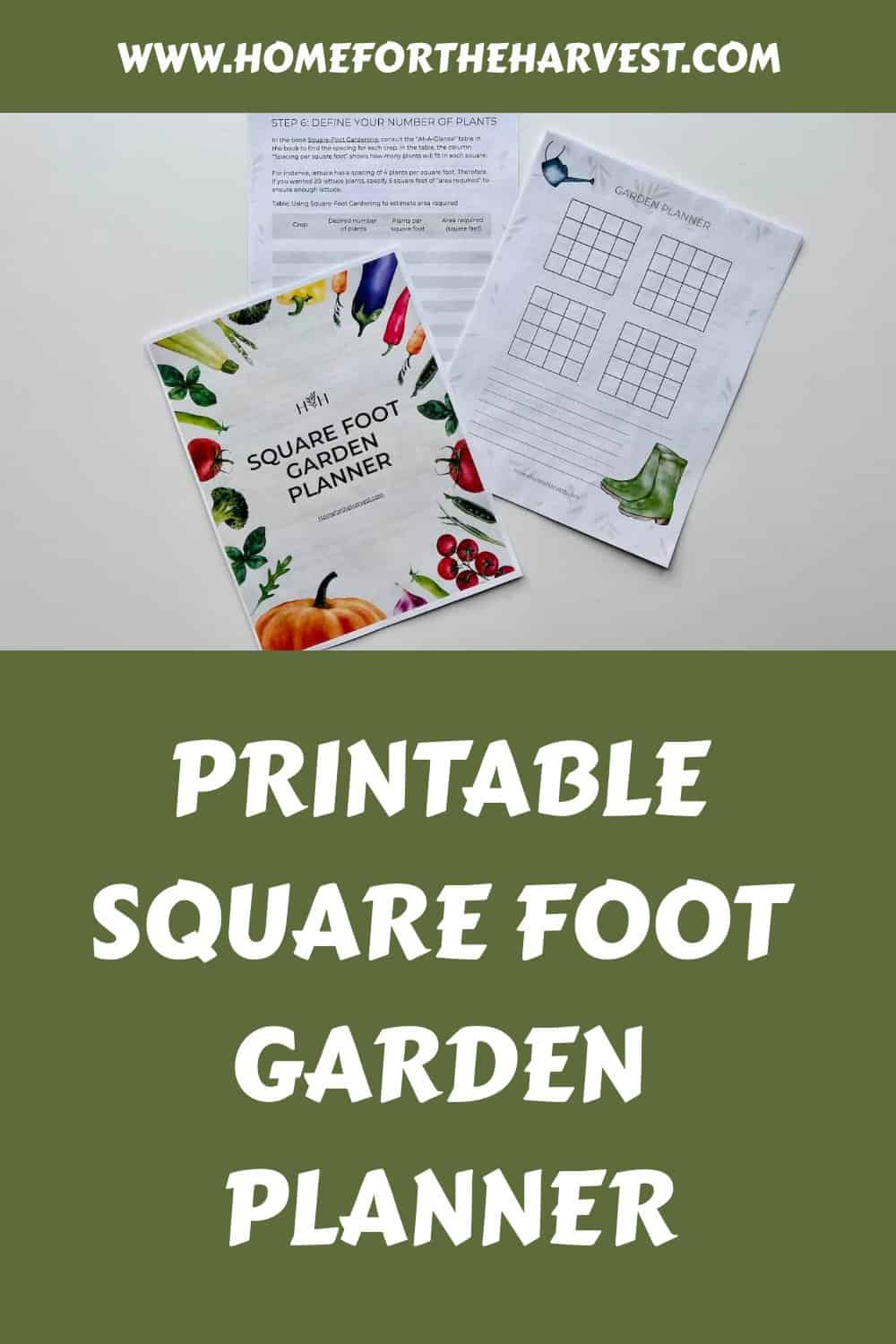Gardening can be a fun pursuit for some, yet getting going may prove challenging. With a printable square-foot garden planner, you can create your dream garden from beginning to end with confidence. From choosing the right plants for your climate and soil type, preparing the soil properly before planting, maintaining healthy growth throughout the season, all the way through harvesting time – this planner has got you covered every step of the way. Here is a printable square-foot garden planner!
Printable square-foot garden planner basics
Are you ready to get your hands dirty and plan the perfect square-foot garden? Once you have done the necessary preparation, you can look forward to an amazing garden that will bring joy for years. Our printable square-foot garden planner is designed to help you plan and prepare for success.
Here is the download form for the printable square-foot garden planner:
1. Plan your garden
Start by deciding on the size and shape of your garden. Measure out the area in feet or yards so you know how much soil and plants to purchase. Make sure there’s enough room for all your desired plants while leaving some extra space for pathways between them. Once everything is planned out, mark off each plant location with stakes or string so nothing gets confused during planting time.
2. Choose the right plants
Selecting plants that are well-suited for your climate is key to having a successful square-foot garden. Look up what grows best in your area, then choose a variety of vegetables, herbs, fruits, flowers, etc., based on their growing needs (sunlight requirements, spacing needed). To make it easier on yourself when shopping at nurseries or online stores – use our printable list as a handy reference guide.
3. Prepare the soil
Now that everything has been planned out it’s time to start prepping the soil before planting begins. Start by removing any existing weeds from the area then loosen up any hard clumps with a rake or hoe if necessary – this will allow air & water to penetrate more easily into the roots once planted. For best results add organic matter like compost or aged manure into each bed before adding new soil – this will give essential nutrients back into depleted soils which helps promote healthy growth & flowering throughout season-long blooms.
Once the preparations are complete, it’s time to sow and transplant according to plan while maintaining adequate spacing between rows for optimal sunlight exposure (at least 6 hours). Avoid overcrowding as this could cause issues later on due to a lack of air circulation between different types; instead, try spacing out rows slightly for adequate amounts of sunlight (at least 6 hours) throughout the day. Don’t forget regular maintenance tasks such as weeding and mulching around bases every few weeks along with pruning overgrown branches where necessary, so that everything looks neat and tidy year-round for maximum enjoyment. Keywords: plan, prepare soil, plant maintain, harvest time
Congratulations – you’ve done it. All that hard work has paid off and now it’s finally time to reap the rewards of delicious home-grown produce. Harvesting times will depend on the type of vegetable, but typically two to three months should be enough for a successful yield. Enjoy and savor the taste of freshly picked ingredients knowing you put a lot of love and effort into creating a beautiful edible oasis in your own backyard.
With a printable square-foot garden planner, you can easily create the perfect outdoor space for your home. Let’s examine how to utilize this helpful tool for devising your garden.

Plan your garden
Planning your square-foot garden is an important part of ensuring a successful harvest. With the right preparation and planning, you can create a lush, productive garden in any space. Our printable planner will help you get started with ease.
Determine the amount of area accessible for your garden and set up a grid by marking with string or posts to keep track of where everything goes. Measure the area and decide on the size of each square foot section – this will depend on what plants you plan to grow. Once you’ve determined the size of each square foot section, mark out your grid using string or stakes so that it’s easy to keep track of where everything should go when planting time comes around.
Next up is choosing which plants to include in your garden plot. Consider factors like climate, soil type, sun exposure, and water availability when making decisions about what varieties are best suited for your particular environment. Try to rotate areas between different plant families; some examples are tomatoes (Solanaceae), carrots (Apiaceae), and squash (Cucurbitaceae). Additionally, think about how much maintenance each variety requires – some crops may need more frequent watering or fertilizing than others – so that you don’t end up with too many high-maintenance plants at once.
Once all of these details are settled upon, it’s time to prepare the soil for planting season. Begin by removing any weeds or debris from the area, then spread a layer of compost across the topsoil before tilling lightly with a shovel or rake until everything is mixed together evenly. Make sure there aren’t any large clumps as they can inhibit root growth later on down the line; if necessary break them apart manually before moving on planting day.
Once it’s time to begin planting, use our handy printable planner as a reference guide. Ensure that you don’t overcrowd the individual sections and leave enough room between each seedling for proper development. Cover lightly with mulch then give your garden an ample drink of water until everything is thoroughly moistened – depending on weather conditions this may need repeating every few days during the germination phase only; afterward, regular irrigation should suffice nicely without breaking the bank or wearing you out too much.
Finally, maintain your garden regularly according to manufacturer instructions while keeping an eye out for signs of pests or diseases such as yellowing leaves or wilting stems. Prune back any excess foliage accordingly and remember to harvest when it’s due; otherwise, you may miss out entirely. Being aware ahead of time helps prevent this from happening.

Choose the right plants
When planning a square-foot garden, choosing the right plants is key to success. Before planting, contemplate the local climate and soil conditions, as well as how much light each plant requires to thrive. This will help you narrow down which types of vegetables, herbs, flowers, and other plants are best suited for your location.
Tomatoes, peppers, and squash can be planted in a square foot garden since they require less room than bigger veg like cauliflower or broccoli. Herbs like basil, oregano, and thyme can be planted together in one section since they all require similar conditions. Flowers that thrive in small spaces include marigolds, zinnias, and petunias; just make sure to leave enough room between them so they have enough air circulation when fully grown.
When it comes to soil type for a square-foot garden, opt for something light yet nutrient-rich with good drainage capabilities. For example, sandy loam soils are ideal because they retain moisture but still allow excess water to drain away from the roots of the plants quickly. If you’re unsure about what kind of soil is best for your particular area then consult an expert at your local nursery or gardening center who can advise you on which types are most suitable for growing certain kinds of plants in a square-foot garden setting.
Choosing the right plants for your square-foot garden is an important step in creating a successful and thriving space. Preparing the earth in an optimal manner will guarantee that your chosen vegetation obtains all of the sustenance they require to flourish robustly and stay healthy.
Prepare the soil
Soil preparation is an essential step for any successful square-foot garden. The soil in your square-foot garden should be loose, light, and full of nutrients so that the plants can easily take root and thrive. To achieve this, you’ll need to make sure that the soil has good drainage and air circulation.
Start by removing all weeds from the area where you plan to create your square-foot garden. Next, add compost or other organic matter like manure or peat moss to enrich the soil with nutrients and improve its texture. You can also mix in a slow-release fertilizer for extra nourishment if desired. Be sure to work it into the top 6 inches of soil with a rake or hoe until everything is evenly distributed throughout the bedding area before planting begins.
If you have clay soils in your yard, adding sand will help loosen up heavy clumps while improving drainage at the same time. For sandy soils, incorporate some organic matter such as compost or leaf mold to help retain moisture longer between waterings. Additionally, consider testing your soil pH levels prior to planting; most vegetables prefer slightly acidic conditions ranging from 5-7 on a scale of 1-14 (with 7 being neutral). If needed adjust accordingly using lime or sulfur depending on what type of results are found during testing—this will ensure optimal growth when the gardening season arrives.
Once the necessary preparations are finished, it’s time to commence planting. It is important not only to select appropriate plants but also to space them correctly within each individual box so they have plenty of room for roots without overcrowding each other out which could lead to potential problems down the line including pest infestations and disease spread. By following these steps carefully, you will be able to set yourself up for success when creating perfect square-foot gardens every single time.
After preparing the soil, it is now time to plant and maintain your garden. Planting and maintaining a square-foot garden requires careful planning and execution of gardening techniques for successful results.
Plant and maintain
When it comes to planting your square-foot garden, you’ll want to make sure you choose the right plants for the space. It is important to research what type of plants are best suited for your climate and soil conditions. When selecting plants, be mindful of their needs in terms of sunlight and soil pH to ensure optimal growth. Additionally, if you plan on growing flowers in your garden be sure that they won’t crowd out other plants or take up too much space.
Planting and tending to your square-foot garden can bring about a generous yield in no time at all. As it is now Harvest Time, we can look forward to reaping what has been sown.
Harvest time
Harvest time is an exciting part of the gardening process. It’s the moment when all your hard work pays off and you get to reap the rewards. Reaping the benefits of a square-foot garden requires knowledge of when and how to harvest for optimal results.
Before collecting your garden’s produce, it is essential to identify the planted crops. Different plants require different methods of harvesting; some are best harvested as soon as they ripen while others should be left on the vine until fully mature. Knowing which type of plant you’re dealing with will help ensure that you don’t miss out on any potential bounty from your square-foot garden.
Once you’ve identified which plants need harvesting, it’s time to start picking. For most fruits and vegetables, simply grab them at their stem or base and gently pull them away from the plant – no tools necessary. Some crops may require more specialized tools such as pruners or scissors for cutting back vines or stems; make sure to read up on specific instructions before getting started so that nothing gets damaged in the process.
When it comes time to harvest root crops like potatoes or carrots, there are a few extra steps involved in order to ensure success: First, loosen up soil around each vegetable with a spade or trowel before carefully digging them out by hand (or using appropriate tools). This will prevent damage from occurring during extraction – something that can greatly reduce yields if not done properly. After extracting each vegetable, lay them out in a single layer so they can dry off completely before storage; this helps keep rot and other spoilage issues at bay over extended periods of time.

FAQs about printable square-foot garden planner
How do I plan a square-foot gardening layout?
Determine the amount of area accessible for your garden and set up a grid by marking with string or posts to keep track of where everything goes. Measure the area and decide on the size of each square foot section – this will depend on what plants you plan to grow. Once you’ve determined the size of each square foot section, mark out your grid using string or stakes so that it’s easy to keep track of where everything should go when planting time comes around.
Before you go…
Gardening is an excellent way to spend time outdoors and savor the natural world, all while creating something captivating. With the help of our printable square-foot garden planner, you can plan your perfect outdoor space with ease. Whether it’s planning out which plants will thrive in each area or learning how to maintain them properly, this guide provides all the information needed for an enjoyable gardening experience that yields delicious results. So grab your tools and start planting today – happy harvesting.






